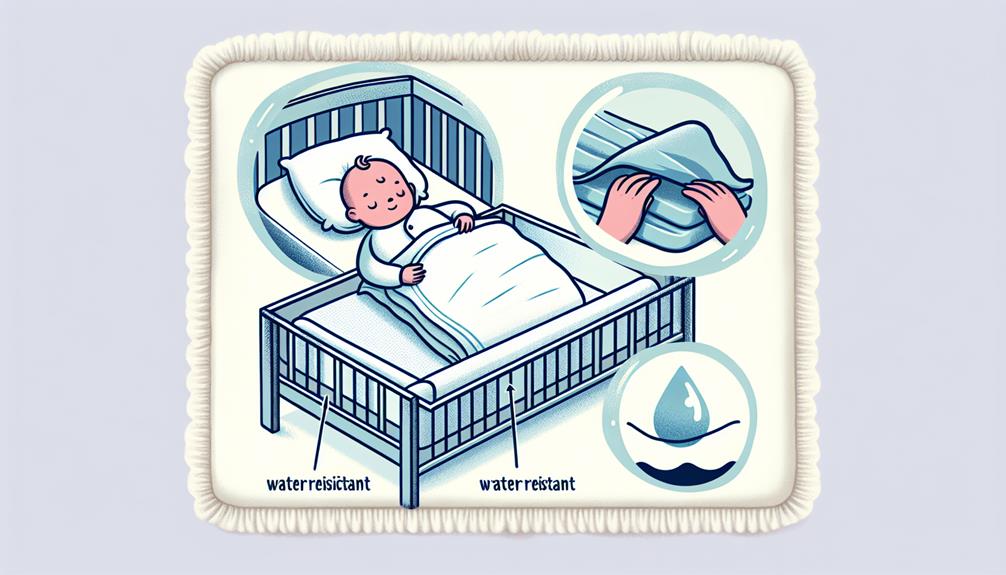Choosing a crib mattress is a crucial decision for parents, as it directly impacts the safety and comfort of their child during sleep. With various types available on the market, ranging from foam to innerspring mattresses, making an informed choice can seem daunting. Factors such as firmness, materials used, and breathability play a significant role in this decision-making process.
However, beyond these initial considerations lie important safety standards, maintenance tips, and ways to extend the lifespan of the crib mattress. These aspects are essential for ensuring a secure and restful environment for your baby, warranting a closer look into the world of crib mattresses.
Key Takeaways
- Comfort, safety, durability, and budget are vital for choosing the right crib mattress.
- Look for safety certifications, waterproofing, and firmness to promote a healthy sleep environment.
- Maintain the mattress with covers, regular cleaning, and proper rotation for longevity.
- Consider factors like material, firmness, and dual-sided options for an ideal crib mattress choice.
Types of Crib Mattresses
When selecting a crib mattress, parents can choose from various types to meet their specific needs and preferences.
One common type is the innerspring mattress, which provides a traditional feel with its steel coils offering support and durability.
In contrast, foam mattresses are lightweight and often more affordable, making them a popular choice for many parents.
Organic crib mattresses, made from natural materials such as organic cotton or wool, cater to those seeking environmentally friendly and hypoallergenic options for their baby.
Additionally, dual-sided crib mattresses offer different firmness levels on each side to accommodate the varying needs of infants and toddlers as they grow.
Waterproof crib mattresses are also available, providing easy cleaning and protection against spills and accidents.
Understanding the different types of crib mattresses allows parents to make an informed decision based on factors such as comfort, safety, durability, and budget, ensuring a peaceful night's sleep for both baby and caregiver.
Key Factors for Choosing
To ensure the best choice for your baby's crib mattress, it is essential to consider key factors that prioritize comfort, safety, durability, and budget.
Comfort is paramount for your baby's quality sleep, so selecting a mattress with adequate support and cushioning is crucial. Look for materials like memory foam or innerspring coils that offer a balance of firmness and softness.
Safety is non-negotiable when it comes to crib mattresses. Opt for products that meet safety standards, have proper ventilation, and are free from harmful chemicals.
Durability is another essential factor to consider, as you want a mattress that will last through your baby's early years without losing its shape or support.
Safety Standards and Certifications
Safety standards and certifications play a crucial role in ensuring the quality and reliability of crib mattresses for infants. When choosing a crib mattress, it is essential to look for the following:
- Certifications: Look for mattresses that meet safety standards set by organizations like the Juvenile Products Manufacturers Association (JPMA) or CertiPUR-US. These certifications ensure that the mattress has been tested for harmful chemicals and meets stringent safety requirements.
- Firmness: Ensure the mattress meets the firmness standards recommended by pediatricians to reduce the risk of Sudden Infant Death Syndrome (SIDS). A firm mattress provides a safe sleeping surface for infants and helps prevent suffocation hazards.
- Waterproofing: Opt for a mattress with waterproofing features to protect against spills, leaks, and accidents. Waterproofing not only prolongs the life of the mattress but also prevents mold and bacteria growth, promoting a healthier sleep environment for your baby.
Maintenance and Cleaning Tips
Ensuring the longevity and cleanliness of your crib mattress involves implementing effective maintenance and cleaning practices.
To maintain a healthy sleeping environment for your baby, it is recommended to use a waterproof mattress cover to protect the mattress from spills, leaks, and accidents.
Regularly inspecting the mattress for any signs of wear and tear, such as tears, holes, or sagging areas, is essential. If any damage is detected, immediate repairs or replacements should be made to uphold safety standards.
Vacuuming the mattress surface periodically can help remove dust, dirt, and allergens that may have accumulated over time.
In case of spills or stains, it is advisable to spot clean the affected area with a mild detergent and warm water. Avoid using harsh chemicals or excessive moisture during cleaning to prevent damage to the mattress materials.
Prolonging Crib Mattress Lifespan
Prolonging the lifespan of a crib mattress requires consistent care and attention to maintenance practices. To ensure your crib mattress lasts for as long as possible, consider the following:
- Rotate the Mattress: Regularly rotating the crib mattress can help distribute weight and wear more evenly, preventing sagging and indentations in specific areas. Aim to rotate the mattress every few months to promote uniform usage.
- Use a Mattress Protector: Investing in a waterproof and breathable mattress protector can shield the crib mattress from spills, stains, and moisture. This additional layer acts as a barrier, preserving the core material of the mattress and keeping it hygienic for longer.
- Inspect and Clean Routinely: Take the time to inspect the crib mattress for any signs of damage, such as tears or punctures. Additionally, clean up any spills promptly and follow the manufacturer's guidelines for proper maintenance. Regular upkeep can prevent issues from escalating and extend the mattress's longevity, providing a comfortable and safe sleeping environment for your little one.
Frequently Asked Questions
Can a Crib Mattress Be Used Without a Crib?
Yes, a crib mattress can be used without a crib, as long as it fits securely and safely in another sleeping surface, such as a toddler bed or playpen. It is important to ensure that the mattress is firm and flat to reduce the risk of suffocation.
Always follow the safety guidelines provided by the mattress manufacturer and make sure the sleeping surface is free of any hazards that could pose a danger to the child.
Are Crib Mattress Toppers Necessary for Extra Comfort?
In the pursuit of ultimate comfort, individuals often seek enhancements to elevate their experiences. Crib mattress toppers serve as a cushioning layer designed to provide an added level of coziness and support.
These accessories can make a significant difference in the overall feel of a mattress, tailoring the sleeping surface to individual preferences. Whether for extra softness or additional firmness, crib mattress toppers offer a personalized touch to enhance comfort and promote restful nights.
Can Crib Mattresses Be Recycled or Repurposed After Use?
After use, crib mattresses can often be recycled or repurposed, promoting sustainability and reducing waste. Many recycling facilities accept mattresses for processing, extracting materials for reuse.
Alternatively, old crib mattresses can be repurposed into pet beds, cushions, or even used for DIY projects. By exploring these options, you can extend the lifespan of a crib mattress and contribute to environmental conservation efforts.
How Often Should Crib Mattress Sheets Be Washed?
Maintaining cleanliness in bedding is crucial for overall health. Crib mattress sheets should ideally be washed every 1-2 weeks to prevent the buildup of dust mites, allergens, and bacteria.
Regular washing helps to ensure a hygienic sleeping environment for infants, reducing the risk of skin irritation and respiratory issues.
Following manufacturer's instructions on washing and drying can help prolong the lifespan of the sheets and maintain their quality.
Are There Any Specific Crib Mattress Accessories That Are Recommended for Safety or Convenience?
When it comes to ensuring safety and convenience, specific accessories can enhance the functionality of products.
In the case of crib mattresses, it is essential to consider accessories such as waterproof mattress protectors to safeguard against accidents and spills.
Additionally, mattress pads can provide an extra layer of comfort for your little one.
These accessories not only promote convenience but also contribute to maintaining the longevity of the crib mattress.
Conclusion
In conclusion, selecting the right crib mattress is essential for ensuring a safe and comfortable sleep environment for infants.
By considering factors such as mattress type, safety standards, and maintenance practices, parents can prolong the lifespan of the mattress and provide a secure sleeping space for their child.
Remember, 'a stitch in time saves nine' – investing in a quality crib mattress now can prevent future issues and ensure a restful night's sleep for your little one.

